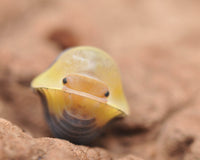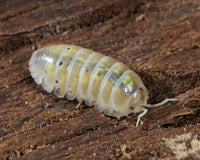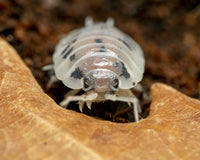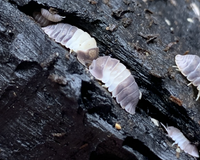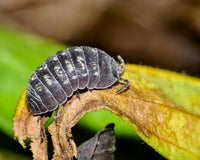So what do Isopods EAT in Nature? Our goal at Rubber Ducky Isopods is to HELP YOU build a thriving Bio-Active Isopod enclosures that best mimic Mother Nature on a microcosm level.
The first step in bringing the "Old Growth Forrest" indoors is to mimic some of the primary food sources for Isopods found in Nature...
- Dead & Decaying Rotting Wood (Preferably Soft)
- Dead & Decaying Cork Bark (Mist Often To Soften)
- Organic Oak Leaves
- Organic Magnolia Leaves
- Organic Bananas Tree Leaves
*FREE Of Pesticides & Fungicides
Over time as you mist and pour both de-chlorinated water and chloramine water over cork bark, that same cork bark will begin to break down. When this occurs, you allow your newly forming Isopod colonies a place to hide and start to establish a healthy environment to breed in.
Cork Bark as an essential food source makes economic sense because it takes much longer to break down than conventional decaying or softened wood. Our goal with this article today is to teach you how to breed and care for your isopods for pennies on the dollar compared to traditional thinking and store-bought nutritional sources.
(Still need traditional store-bought nutritional sources for exceptional Isopod breeding? We have you covered AND finally at a fair price $9.49 Each AND Includes Shipping)
- Bee Nectar Pod Protector ©
- Out The A** Insect Frass ©
- Pea Pods For Isopods ©
- Pod Beast Yeast Feast ©
- Real Deal Crab Meal ©
Isopods Love Decaying Leaf Litter As A Food Source
When we first started collecting Isopods, a quick Google search made us believe we had to buy expensive isopod food to flourish our breeder colony enclosures. However, this could not be more inaccurate.
As our skillsets began to improve month after month, we soon realized that our success rates seemed to increase tenfold when we focused on building a living soil where our isopods could dig/burrow and breed within.
When we first started building our Living Soil Isopod Substrate mediums we used the Soil Foodweb as our guiding principle, we quickly learned about organic matter decomposers.
Isopods, in short, are incredibly proficient soil-dwelling organic matter decomposers. Despite the various Organic Matter Decomposers, we would like to focus on what we consider to be the five primaries for this article.
- Red Wiggler Composting Worms
- African Nightcrawler Composting Worms
- European Nightcrawler Composting Worms
- White Springtails
- Rove Beetles
This combination has become part of the tangible foundational steps it takes to build Bio-Active Terrariums and Vivariums, in addition to working together in a symbiotic relationship with our beloved Isopods.
Living Soil Dwelling Organic Matter Decomposers

- African Nightcrawler Composting Worm
- Alabama/Georgia Jumper Composting Worm
- European Night Crawler Composting Worm
- Red Wiggler Composting Worm
- White Springtail Mites (Tropical)
African Nightcrawlers: (Eudrilus eugeniae)
Preferred Burrow Depth: 6" to 8" These highly active composting worms are the perfect hybrid of attributes between the Red Wiggler composting worm and the European Nightcrawler.
Much more extensive than the Red Wigglers and more versatile and sleeker than the European Nightcrawler, the African Nightcrawler is our favorite composting worm to use in conjunction with our Cubaris sp (Tropical) isopods.
Alabama/Georgia Jumper: (Amynthus gracilus)
Preferred Burrow Depth: 6" to 8" The reason this composting worm became known as a "jumper" is due to its incredible ability to rock itself back and forth so quickly and violently that it can jump right out of your hand!
Known for digging deeper oxygen channels within your soil systems, the Alabama/Georgia Jumper is excellent at breaking down and breaking through compacted soils.
European Nightcrawler: (Eisenia hortensis)
Preferred Burrow Depth: 3" to 8" The European Nightcrawler has become somewhat famous for being the "big brother" composting worm to the Red Wiggler.
Keeping roughly the same soil depth profile as the African Nightcrawler, this enormous composting worm consumes more considerable amounts of decaying matter and builds larger dissolved oxygen channels.
Red Wigglers: (Eisenia foetida)
Preferred Burrow Depth: 2" to 4" By far, the most recognized and popular composting worm, these hardy and robust composting worms consume just about anything you feed them.
In addition to their sizable appetites, their preference to consume and break down organic material found at the "soil floor" level of our bioactive enclosures provides the perfect balance.
Red wigglers are THE choice for beginner isopod farmers who want to start working with both species to improve their bioactive vivariums and terrariums' overall health.
White Springtail Mites: (Collembola)
Preferred Burrow Depth: .5" to 3" With just some basic research, you could easily overlook the importance of springtails and how pivotal a role they play in conjunction with our isopod colonies.
White Springtails prefer to break down animal feces, decaying wood and plant matter, as well as protein and vegetable sources. An almost identical diet to your isopods and the best part of using Mother Nature to improve Mother Nature is that your isopods and springtails will work within a symbiotic relationship to feed and nourish one another!
Below Is A Presentation I Created To Build Bio-Active Living Soil Systems
Isopods Love To Eat Cork Bark As Food
(Decaying or Softened Wood Found In Nature)

Isopods Love Decaying Leaf Litter As A Food Source
When we first started collecting Isopods, a quick Google search made us believe we had to buy expensive Isopod food to flourish our breeder colony enclosures. However, this could not be more inaccurate.
As our skillsets began to improve month after month, we soon realized that our success rates seemed to increase tenfold when we focused on building a living soil where our Isopods could dig/burrow and breed within.
Old Decaying Leaf Litter Is THE Best For Isopod Food Sources

- Organic Magnolia Tree Leaves
- Organic Oak Tree Leaves
- Organic CBD Hemp Flower
- Organic CBD Hemp Flower Stalks
- Organic CBD Hemp Fan Leaves
Mother Nature is superior because she understands that a diverse balance and harmony of beneficial microbes must be achieved each season for a correct balance to occur year after year.
4 Seasons Help Breakdown Food Sources For Isopods

Spring: In this season, Mother Nature focuses on creating a new and abundant life by building a healthy root structure for newly developing plants.
The Rhizosphere (See The Above Video) is where this magic begins to form in the Spring. These root structures give off exudates (sugars/carbohydrates) that attract diverse groups of soil microorganisms.
The more varied sets of microorganisms you have, the easier it is to maintain and build a thriving mini-ecosystem for your isopod colonies.
Summer: In this season, Mother Nature focuses on healthy plant growth in conjunction with the beginning stages of flower production. During these crucial months, the plant's daily focus is on how much chlorophyll and photosynthesis they can achieve daily.
Remember, a plant cannot run away from pests and diseases, so the only way to defend herself from these dangers is to grow as healthy and robust as possible. This defense is why many organic farmers choose to focus on a High Brix Levels to help keep their plants healthy, pest and disease-free.
Fall: In this season, Mother Nature focuses on returning valuable nutrients to the forest floor. During this process, organic matter decomposers begin to show why they are crucial to a healthy Soil Foodweb.
As the leaves start to fall from the trees, this is when the real magical transformation begins to occur! Old plant material is broken down into smaller pieces to provide nutrient sources for next year.
Winter: In this season, Mother Nature continues to show her real magic when breaking down organic matter into high-quality nutrients for the next season.
Winter is literally when the living soil systems start to be built and feed the upcoming microbial world with higher and higher available Carbon and Calcium year after year!
These four seasons each play a significant role in breaking down organic matter into Carbon. What is Carbon?
Carbon: This is like the currency or money supply of the soil microbial world. More Carbon equates to more money. In turn, more exchanges will occur within the microbial world. These exchanges help to build the diverse Soil Foodweb that we have become well known for!
Check Out Our Other Articles Here:
Managing Fungus Gnats Building Isopod Substrates
Improving The Overall Health Of Bio-Active Substrates For Isopods








